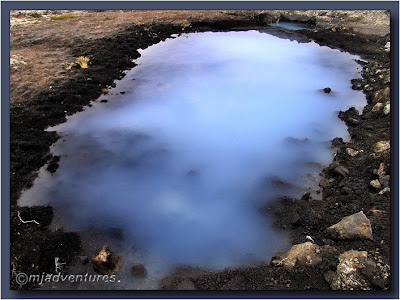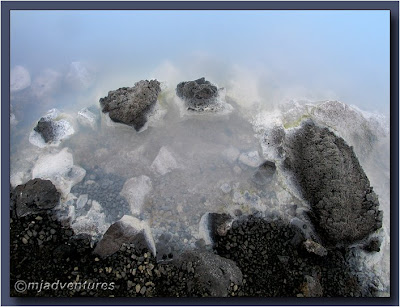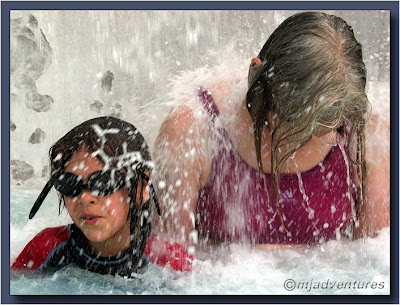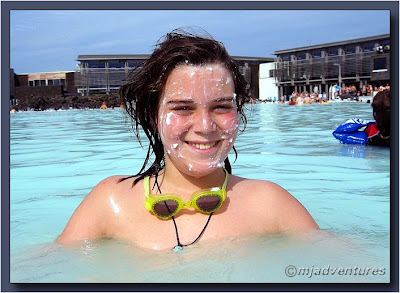One thing that's great about Reykjavik is that some excursions are free for kids under 12 years of age - including bus transfers to and from Keflavik International Airport. Of course, the prices for the adults more than make up for it, but when averaging out the costs of doing things as a family, it made the charges somewhat more bearable to take.
Once out of the capital, costs for kids become scalable and depend on the area, individual tour operator whims and each transport company's fare tariffs.
We stayed in Reykjavik for 4 days and really only used it as a base for sleeping while we travelled out of the city to see other things - mainly in the south-west and within easy driving times so that we didn't succumb to killing the impatient kids by boiling them alive in the nearest thermal hotpool. As it was, within 10mins of getting in the car and before we'd even get off the Reykjavik ring-road motorway, one of them would ask how much longer it was going to take!
One thing we learned pretty quickly is that there are not many good maps of Iceland or Reykjavik to be found online. Google Earth hasn't officially mapped the country and rumour has it that the Icelandic Government wanted too much money from Google in exchange, so it hasn't been done.
We found the best maps to obtain were these two freebies which we picked up in the bus depot:
 The Map of Reykjavik is self-explanatory, and the Big Map shows the roads for the whole of Iceland which is pretty much one road running all the way around the perimeter of the island, with a few roads leading into the center. What interior roads are present are only accessible by 4WD vehicles. The Icelanders love their 4WDs - the more souped-up, raised-up and big-tyred, the better they are!
The Map of Reykjavik is self-explanatory, and the Big Map shows the roads for the whole of Iceland which is pretty much one road running all the way around the perimeter of the island, with a few roads leading into the center. What interior roads are present are only accessible by 4WD vehicles. The Icelanders love their 4WDs - the more souped-up, raised-up and big-tyred, the better they are!The most famous church on the front of the Reykjavik Map is Hallgrimskirkja which towers over the city. Long before arriving in Iceland I was looking forward to photographing it as it's an awesome structure, and I love to shoot interesting architecture. To my immense and deep disappointment, the cathedral was covered in obtrusive scaffolding as it undergoes renovation and I couldn't even bring myself to visit it. Next time.
J was still trying to keep to her running schedule as she prepares for the Berlin Marathon, so the kids and I took a walk to the waterfront and into the main tourist area of the city.
The boys had fun clambering over a modern stainless steel sculpture of a Viking ship, much to the chagrin of other people wanting to take photos. I had to call them off it before the under-breath mutterings from the people around me became audible, vociferous abuse. I also used the op to get my own kid-free image!

We then walked up from the harbour into the main area of the city.


We spent a few minutes looking at a vast photographic wall displaying images of Icelandic children.

Walking up the main street to go grocery shopping, we passed a shop selling Arctic Wolf skins. The boys had to closely inspect a pelt hanging outside the shop which still had the wolf's paws attached to it. Fascinating in a morbid way. I was quietly pleased that both kids walked away a little subdued at the thought that a beautiful creature had died for that pelt. They're both now at an age where things like this impact upon them.

Reykjavik has a small town feel about it, and it's certainly the hub for all things touristy. The BSI Bus Terminal (the Tourist/Excursion Bus Depot) has a lot of pamphlets and brochures on the available sight-seeing tours as well as booking counters to buy tickets. The most popular trips would be the Puffin Express, Whale Watching, Blue Lagoon and the Golden Circle Route which takes in Strokkur Geyser, Gullfoss waterfall and Þingvellir (pronounced Thingvellir) National Park.
We had a day where we were vehicle-free, so we chose to hop onto a bus to the Blue Lagoon to soak in some warm water as it was very grey, cool and overcast. In Iceland, the tour buses have seatbelts for the passengers which I've always thought to be a great idea and have often wondered why countries don't make this compulsory for their tour bus operators.
The Blue Lagoon (Bláa Lónið) complex is closer to Keflavik, so the bus travels along the main Reykjavik-Keflavik highway before turning off to head for the geothermal area.
The bathing pools are fed geothermal heated seawater from the nearby power station which can be seen in the distance while bathing. The superheated 240°C water passes through the station where it is used to generate power as well as being processed for municipal use. The rest of the water (now at about 40°C) is pumped into the Blue Lagoon pools for bathers to wallow in. The water is rich in silica and sulphur and nicely warm. I'm used to mineral hotpools in New Zealand so I wasn't totally blown away by it all, but it was a great experience which we repeated on our last day in the country.
Blue Lagoon is efficiently managed. Towels and bathing costumes can be hired at extra charge, the changing rooms are modern, clean and well-maintained. Hygiene standards are strict and everyone is required to shower before entering and after exiting the pools. The nifty entry bracelets also double as electronic keys for locking and unlocking the personal storage lockers. Food and drinks can also be charged onto the bracelets and paid for upon exiting the building - a dangerous nicety given the high prices. Luckily the kids' bracelets are programmed so that they can't charge anything to them or manage their own lockers!
As well as the main pool, there are steam rooms, and at stations around the main pool there are buckets filled with white thermal mud which we smeared over our faces and left to dry before washing off.
The Blue Lagoon also runs a spa treatment area (extra charge of course) and specialises in psoriasis treatment. There is a restaurant and café but we didn't dare go anywhere near them because of the prices. We had prepared our lunch back at the apartment and carried it in a backpack which we took out to the pool area. We were then able to snack when we felt peckish - and with the boys that was pretty much all the time until every crumb of food had been consumed!
To the left of the main building entry door, a pathway leads off around some pools and meanders over little wooden bridges built across the lagoons. Some nice images can be taken in this area given the right conditions. Unfortunately it was very grey and gloomy for us.


 We spent about 3 hours at the pools on each of our visits, timed to coincide with the bus departures. I certainly wouldn't hire a car to go to the Blue Lagoon only to have it sit in the carpark doing nothing when it's cost an arm and a leg to hire it. The buses do a great job of transporting visitors and it's a hassle-free way to travel.
We spent about 3 hours at the pools on each of our visits, timed to coincide with the bus departures. I certainly wouldn't hire a car to go to the Blue Lagoon only to have it sit in the carpark doing nothing when it's cost an arm and a leg to hire it. The buses do a great job of transporting visitors and it's a hassle-free way to travel.As I mentioned at the beginning of this post, kids under 12 are free of charge when doing some things in the city. This included riding the buses to and from the Blue Lagoon, and also entry into the pools.
However, it still cost us approx. €80 for 2 adults to ride the bus and get into the pool - and hire 4 towels. Spread out over a family of 4, it averaged at €20 per head which then didn't sound as bad. At least, that what we tried to convince ourselves into thinking!
Next post: Hiring a car, or how to psyche out the car hire customers.






1 comments:
that place looks amazing!
Post a Comment